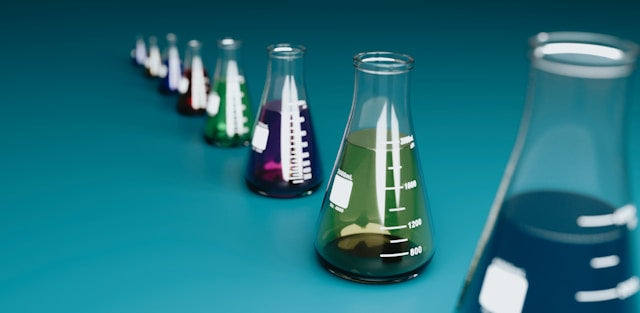
The Quest For Non Toxic Cosmetics
Vicky Lyons
The Hidden Toxins in Everyday Skincare (and How to Avoid Them)
When you buy cosmetics or skincare — whether in a high-end store, supermarket, or online — you probably assume they’re tested and non toxic. Unfortunately, that’s not always true.
Many ingredients proven to cause harm are still legal in cosmetics across the UK, Europe, and worldwide. These toxic ingredients often hide behind greenwashing, “clean” packaging, and vague claims of being “natural.”
Your skin absorbs much of what you apply — and unlike food, what’s absorbed through your skin doesn’t pass through your liver before entering the blood stream. That’s why choosing legitimate non toxic skincare and cosmetics is just as important as choosing non toxic food.
One way to avoid being a victim of greenwashing and find truly non toxic cosmetics is to read the label and learn which ingredients to avoid.
PFAS (“Forever Chemicals”)
What they are:
A group of over 4,700 synthetic chemicals that don’t break down — in your body or in the environment.
Why they’re harmful:
Linked to cancer, thyroid and immune issues, and reproductive harm. These “forever chemicals” don't break down and build up over time, contaminating you and the environment.
Where they’re found:
- Waterproof or long-lasting products
- Sunscreen, lipstick, waterproof mascara
- Creams with a silky texture
How to spot them:
Tricky! Look for “fluoro” or “perfluoro” in ingredient names (e.g. perfluorononyl dimethicone, often shortened to PTFE or its trade name - Teflon). But they are often present and not listed on the label - so avoid 'water-proof' or 'long lasting' claims and brands you just don't trust.
What the research says:
A 2021 University of Notre Dame study found over half of tested cosmetics contained PFAS — yet most didn’t list them on the label.
Phthalates
What they are:
Plasticisers that make products flexible and help fragrances last longer.
Why they’re harmful:
Certain phthalates, such as DEHP and DBP, are linked to hormone disruption and reproductive harm. DEHP is banned in Europe, but diethyl phthalate (DEP) is still allowed in small amounts.
Where they’re found:
- Hair sprays
- Lotions
- Nail polish
- Soaps and perfumes
- Sanitary pads
How to spot them:
Also tricky! Manufacturers can hide phthalates under “fragrance” or “parfum”, so if a product lists either of those, you might not be getting the full picture.
Petrochemical Emollients
What they are:
Petrochemical emollients are ingredients derived from crude oil. They create a coating on the skin that prevents moisture loss, which is why they’re so common in creams and balms.
Why they’re harmful:
Although they can provide short-term softness, petrochemical ingredients such as mineral oil, petrolatum, and paraffin create an occlusive artificial barrier that traps sweat, sebum, and impurities beneath the surface. Over time, this can clog pores and interfere with the skin’s natural renewal process. They can be a disaster if your skin is prone to breakouts acne or perioral dermatitis
Because they are inert and non-biodegradable, they do not nourish or support the skin barrier the way natural plant oils do. They can also prevent the absorption of beneficial botanical ingredients.
From an environmental perspective, they are a by-product of the fossil-fuel industry and not sustainable — an important consideration for those choosing non toxic cosmetics.
Where they’re found:
Petrochemical emollients appear in a huge range of products, including:
- Moisturisers and body lotions
- Lip balms and petroleum jellies
- Baby oils and nappy creams
- Makeup primers and foundations
- Hair conditioners and styling products
How to spot them:
Look for ingredients such as:
- Mineral Oil (also called Liquid Paraffin or Paraffinum Liquidum)
- Petrolatum (petroleum jelly)
- Ceresin, Ozokerite, or Microcrystalline Wax
- Propylene Glycol and Butylene Glycol
Better options:
Choose products made with natural plant oils and butters. These nourish the skin barrier, are not completely occlusive so yoiur skin can continue to fuction normally. They are biodegradable, and fully compatible with non toxic skincare principles.
Preservatives
What they are:
Ingredients added to stop bacteria growing in water-based products.
Why they’re harmful:
All preservatives are biocides — they kill microbes, but they can also disrupt your skin’s microbiome. They’re common triggers for eczema, irritation, and contact dermatitis.
Where they’re found:
Anything containing water — shampoos, lotions, cleansers, sunscreens, and makeup.
Common ones to avoid:
- Parabens (methylparaben, propylparaben) – hormone disruptors
- Formaldehyde-releasing preservatives (DMDM hydantoin, diazolidinyl urea) – linked to cancer and allergies
- Methylisothiazolinone (MI) – banned in leave-on products but still in some shampoos and gels
- Phenoxyethanol – can irritate sensitive skin, especially for eczema and rosacea sufferers
Even “natural” preservatives affect your skin microbiome — remember, they’re all designed to kill microbes. Avoiding these is key when choosing non toxic cosmetics.
Sulphates and Surfactants
What they are:
Cleansing and foaming agents found in most shampoos, washes, and toothpastes. The most common are sodium lauryl sulfate (SLS) and sodium laureth sulfate (SLES).
Why they’re harmful:
SLS is a harsh detergent that strips away natural oils, damages the skin barrier, and increases water loss. Over time, this can lead to dryness, irritation, and sensitivity — particularly for those with eczema or rosacea.
Where they’re found:
Shampoos, face washes, bubble baths, and even toothpaste.
How to spot them:
Look for sodium lauryl sulfate (SLS), sodium laureth sulfate (SLES,) ammonium lauryl sulfate, sodium coco-sulfate, or TEA lauryl sulfate.
Better options:
Choose cold pressed soaps shampoo bars if possible, if not opt for cleansers made with mild, plant-based surfactants.
Emulsifiers
What they are:
Emulsifiers blend oil and water together to make creams and lotions — but they don’t stop emulsifying once on your skin.
Why they’re harmful:
Many emulsifiers continue to break down your skin’s natural lipids after application. When you wash, those bound lipids rinse away — a process known as “wash-out.” This damages your barrier, increases dryness, and causes trans-epidermal water loss.
Where they’re found:
Lotions, moisturisers, creams, and emulsified serums.
Common examples:
- Polysorbates (20, 80) – tolerated by some, irritating for sensitive skin
- PEG-based emulsifiers – known irritants, often contaminated with 1,4-dioxane, a carcinogen
- Laureth-4 – linked to skin irritation and barrier damage, also often contaminated with 1,4-dioxane
Why Dilute Skincare With Water?
Water might sound harmless, but in skincare it’s mostly a cheap filler. It dilutes the active ingredients and creates a breeding ground for bacteria — which means preservatives and emulsifiers are needed to stabilise it.
According to dermatology textbooks, the best way to moisturise skin is to apply natural oils or balms to damp skin, it's what people did for thousands of years, until the chemical companies of the early 20th century invented emulsifiers.
Natural, water-free skincare locks in moisture naturally — no preservatives, no emulsifiers, no need for harsh chemicals. Choosing water-free products is a simple way to ensure you are buying non toxic cosmetics that deliver results safely.
The Lyonsleaf Water-Free Approach
Lyonsleaf balms are all 100% water-free, preservative-free, and emulsifier-free — made only with pure, potent, natural ingredients that support your skin’s barrier rather than strip it away.
Going water-free is easier than you think:
- Use mineral powder makeup instead of liquid formulas
- Switch to shampoo bars and cold-pressed soap
- Replace creams and lotions with water-free balms
- Choose bath salts or oils instead of bubble bath
When you do need a product with water, choose brands that use the gentlest preservatives and the least synthetic additives.
Your skin deserves better.
Join the water-free revolution and discover truly non toxic cosmetics.
References
Scheringer, M. et al. “The global problem of per- and polyfluoroalkyl substances (PFASs).” Environmental Science: Processes & Impacts, 2020. https://pmc.ncbi.nlm.nih.gov/articles/PMC79069522.
Glüge, J. et al. “An overview of the uses of PFAS in cosmetics.” Toxicology Letters, 2024. https://www.sciencedirect.com/science/article/pii/S0278691524001911
Whitehead, H.D. et al. “Fluorinated Compounds in North American Cosmetics.” Environmental Science & Technology Letters, 2021. https://www.ewg.org/news-insights/news-release/study-toxic-forever-chemicals-widespread-across-many-cosmetics
Koniecki, D. et al. “Phthalates in cosmetic and personal care products: concentrations and possible dermal exposure.” Environmental Research, 2011. https://www.fda.gov/cosmetics/cosmetic-ingredients/phthalates-cosmetics
Wang, Y. et al. “Phthalates: Characteristics, occurrence, and human exposure.” Toxics, 2023. https://www.mdpi.com/2673-6179/3/2/11
Dong, R. et al.“Synergistic cytotoxic effects of di-n-butyl phthalate and methylparaben.” Environmental Science and Pollution Research, 2022. https://link.springer.com/article/10.1007/s43188-022-00151-3
Darbre, P.D. “Endocrine disruption and human health: The case of parabens.” Molecular and Cellular Endocrinology, 2017. https://pubmed.ncbi.nlm.nih.gov/29596967
Campaign for Safe cosmetics https://www.safecosmetics.org/chemicals/formaldehyde/
Al-Saleh, I. et al. “Effects of sodium lauryl sulfate on skin barrier function and irritancy.” Toxicology Reports, 2021. https://pubmed.ncbi.nlm.nih.gov/8654070/





